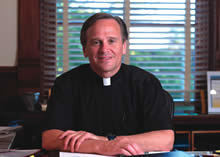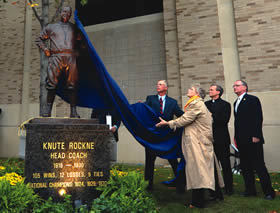
Truman likened being president to riding a tiger. Texan Lyndon Johnson compared it to the plight of a donkey in a hailstorm: “There’s nothing to do but stand there and take it.” Fortunately, the presidency of a university brings many rewards along with the travails of leadership. Last spring Notre Dame’s Class of ’09 named the Rev. John I. Jenkins, CSC, ’76, ’78M.A. its Senior Fellow. In October, the Board ot Trustees elected Father Jenkins to a second five-year term as Notre Dame’s 17th president, effective upon the completion of his first term on June 30. In a separate resolution, the University’s Fellows said Father Jenkins has “combined courageous leadership with the kind of priestly dedication, pastoral concern and inspiration that we have come to expect of a president of Notre Dame.” . . . If there’s a lifetime achievement award for the most dedicated Irish football fans, James Malooly ’55 has earned this nomination. Malooly was 8 when he attended his first game — a 3-0 win over Purdue — in 1939 near the end of the Elmer Layden era. The Chicago real estate agent has attended at least one game a year since, even during those years when his Navy service delayed the completion of his commerce degree. Lately, Malooly attends most home games, most recently the October 24 win over Boston College. We’d like to hear your tales of devotion to any of the school’s 24 varsity programs, too. Write us at ndmag@nd.edu. . . . Irish basketball has a sparkling new home. The men’s and women’s squads opened the Purcell Pavilion at the Joyce Center with exhibition wins in early November. The rehabbed JACC trades in a net 2,000 seats for more comfortable posterior accommodations and a VIP club, but the most noticeable change for first-time visitors may be the improved lighting. “I didn’t realize how dark the old place was,” men’s coach Mike Brey told a tour group in October. . . . Dress for spring glory, bring an umbrella, but plan to come either way if someone you know expects to graduate from Notre Dame in May. Starting this year, commencement will take place in the football stadium on Sunday morning, allowing graduates to invite pretty much everyone they know. The change of venue was due in part to the lost seating capacity in the JACC, which significantly limited the number of family members who could attend there. Plans for the weekend set the graduate and professional school ceremonies and the Commencement Mass on Saturday. Seniors will receive handshakes, diplomas, cheers and awards in separate college and department platform ceremonies on Sunday afternoon. . . . Future Domers may be the primary audience for a pair of new media offerings at the University’s website, but all Domophiles — real and potential — will benefit from recent launches of a virtual campus tour and ND’s point of entry to Apple’s iTunes U. At tour.nd.edu, visitors will find Matt Cashore ’94 photos and panoramas, and take video strolls through more than two dozen campus landmarks from the Grotto to the stadium to the new Geddes Hall, each led by a different student guide from the Office of Admissions. The iTunes U site aspires to be the world’s leading source of free educational media. In this case it means downloadable audio and video podcasts that showcase Notre Dame’s unique academic community through lectures, events and performances, profiles of faculty and research initiatives, the “What Would You Fight For?” TV ads and miscellaneous gems like the greatest play of the Charlie Weis era. The clips are available through iTunes.nd.edu and require the installation of iTunes software. . . .

A life-size likeness of Knute Rockne, sculpted by Jerry McKenna ’62 and unveiled by four Rockne grandchildren during the weekend of the Washington game, holds a commanding position outside the house the coach built, gazing northeast along the plaza between the Joyce Center and Notre Dame Stadium. Rockne’s brothers in bronze, Coach Frank Leahy and athletic director Moose Krause, relax nearby, while coaches Lou Holtz and Ara Parseghian stand inside stadium Gate D. All are McKenna creations. . . .“I love Notre Dame,” said the Most Rev. Kevin C. Rhoades, 51, while introducing himself as the successor to retiring Bishop John M. D’Arcy of the Diocese of Fort Wayne-South Bend. Rhoades has served five years as the Bishop of Harrisburg, Pennsylvania, and built a reputation as a skilled recruiter of seminarians. The Spanish-speaking prelate, who is reportedly attuned to the needs of Hispanic Catholics and is supportive of parochial schools, told an audience of parishioners and local media at South Bend’s Saint Matthew Cathedral that he “wants to have a close personal and pastoral relationship” with the University. Bishops D’Arcy and Rhoades included an appearance at the annual conference of the Notre Dame Center for Ethics and Culture in their rounds, concelebrating a Mass for participants at the Basilica of the Sacred Heart. . . . The shelves in Hesburgh library are getting tight but not fast enough, according to a faculty petition hand-delivered to the Dome by the chairs of the history and theology departments. A 36-page memorandum attached by graduate student David Morris to a parallel student petition lays out the case for a radical increase in spending on acquisitions, research staff, renovations and new storage space for lesser-used materials. Morris argues that the University has not yet made the transition from a curriculum library to a research library. Citing statistics culled by the Association of Research Libraries, he wrote: “If it is unacceptable for Notre Dame to be 56th in the U.S. News rankings, or 56th in the college football polls, it should also be unacceptable for Notre Dame — one of the world’s wealthiest universities and champion of the Catholic intellectual tradition — to have a library that ranks 56th in the country.” . . . Science and engineering administrators can’t explain the respective 26 and 22 percent jumps they saw this year in freshmen stating their intention to study in those colleges. They’re not even sure it’s the start of a trend, but they’re not complaining. . . . Meb Keflezighi grabbed headlines in November as the first American to win the New York City Marathon in 27 years. It was his first marathon victory, and the humble distance runner used the moment to honor his friend, Ryan Shay ’02. At a pre-race press conference, Keflezighi, 34, called for a moment of silence for Shay, who collapsed and died two years earlier during the U.S. Olympic trials. With less than three miles to go during the race, Keflezighi passed the spot in Central Park where his training partner had fallen, making the sign of the cross on his white USA jersey. . . . Financial regulators seeking advice on how to rewrite the investment rulebook after the 2008 stock market failure may find themselves consulting more often with experts at the Mendoza College of Business. Professor Paul Schultz, the inaugural director of ND’s new Center for the Study of Financial Regulation, sees more than an immediate fix-it role for the research and conferences he and his colleagues will produce. As finance grows increasingly complex, the center’s scholarship will evaluate the long-term economic impact of existing and proposed regulations. . . . Remember the Alamo? Shoot. The question is how several thousand Irish fans could ever forget the twilight pep rally they attended at the historic Texas fort’s doorstep the night before the experimental October 31 “home away” football game in San Antonio against Washington State. . . . The decision to close the “heterodox” Department of Economics and Policy Studies drew national attention through news stories and commentary published in The Chronicle of Higher Education. The University erected the 11-member department in 2003 as an experimental, breakaway home for economists whose work approached questions about poverty, social justice and development from multiple schools of economic thought. It has operated alongside the rising, mainstream emphasis on quantitative analysis and neoclassical perspectives that students today find in the Department of Economics and Econometrics. This year officials determined the split is no longer tenable. But Professor David Ruccio told the Chronicle that the closure of his academic home means that “non-mainstream ideas [and] openness to a variety of traditions, are no longer going to be central” at Notre Dame. He and his colleagues may seek new berths in other departments or research centers across the University. . . . The Student Senate confronted the discontents of ND undergraduate intellectual life in October, proposing ideas that include required reading for incoming freshmen, more classes in residence halls and moving discussion groups into informal settings. “There is this sense of ‘keep it for the classroom.’ So when you do bring it up, you get shot down about it or you have to preface a lot of what you say with, ‘This is really nerdy,’” said Senator Denise Baron, a senior. . . . The theology department was thrice honored for its expertise last year by calls for assistance from the Vatican. In October Rev. Paulinus Odozor, C.S.Sp., a moral theologian, advised the papally convened Second Special Assembly for Africa of the Synod of Bishops. Rev. Daniel Groody, CSC, ’86 and a team of six other scholars gathered in November to develop the final document produced by the World Congress on the Pastoral Care of Migrants and Refugees. And department chair John Cavadini, the director of ND’s Institute for Church Life, accepted the Holy Father’s appointment to the International Theological Commission, a panel of 30 theologians that advises the Congregation for the Doctrine of the Faith, the Vatican’s authority on Church doctrine. Cavadini was also named a knight of the Papal Order of Saint Gregory the Great, whose members are exemplary for their support of the Holy See and their faith witness and service to the Church in their communities. . .As plain-spoken as he is wealthy, Texas oilman T. Boone Pickens says at age 81 he’s too old to fix the growing problem of American dependence on foreign oil. “This is your problem,” he told an audience of more than 1,000 students and local residents at Leighton Concert Hall. Pickens, famous for his advocacy of massive wind farms as a key to future U.S. energy solutions, focused his remarks on the replacement of foreign-derived vehicle fuels with domestic natural gas, starting with big polluters like the heavy-duty diesel trucks that pick up trash in our neighborhoods. . . . A wedding band turned up in the collection taken during the Folk Choir’s annual Concert for the Missions in November. The anonymous donor expressed regret for a failed marriage, but hoped the contribution would help support the Church’s outreach to families in Peru.